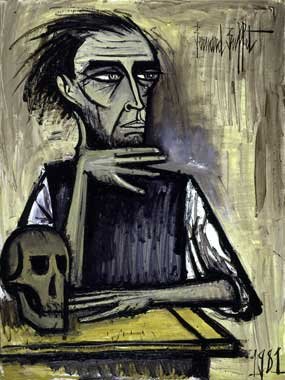Bernard Buffet
dal 17/4/2008 al 2/8/2008
Segnalato da
17/4/2008
Bernard Buffet
MMK - Museum fur Moderne Kunst, Frankfurt
The exhibition showcases 60 works stretching across six decades of artistic endeavor by an artist who found the images to describe post-War sensitivities. He hardly varied his style through the decades, but with it he transformed an inconceivable number of themes, be they violent or trivial, into paintings. His oeuvre contains series of works on the Passion of Christ, on Dante's Divine Comedy, or on the theme of death, just as it does cityscapes, apes and automobiles.

As the first major museum exhibition in Germany for many year, the MMK Museum für Moderne Kunst is showcasing 60 works by Bernard Buffet (1928 – 1999) stretching across six decades of artistic endeavor. The exhibition is thus dedicated to an artist who was once feted as being one of France’s most important painters and the legitimate successor of Picasso. As the 'painter of existentialism' and the man who found the images to describe post-War sensitivities, Buffet’s works had a visual presence and renown in West Europe that almost no other painter has achieved since. This immense popularity in the 1950s and 1960s was followed by critics and the institutional art world both rejecting his work most incisively. The vitriolic tone of this rejection intimates that Buffet should be considered someone who was suppressed rather than forgotten. And a knowledge of his oeuvre is usually based on a few themes that thanks to their mass dissemination and popularity have taken deep root in our memories. This limited awareness contrasts sharply with the sheer infinite range of his subject matter and his incredible productivity.
He hardly varied his style through the decades, and more recent commentators have termed it »congealed«, »frozen« and »cold«, but with it Bernard Buffet transformed an inconceivable number of themes, be they violent or trivial, into paintings. His oeuvre contains series of works on the Passion of Christ, on Dante’s »Divine Comedy«, or on the theme of death, just as it does cityscapes, apes and automobiles. Thanks to this unmistakable style, Bernard Buffet emerged as a trademark brand, one also lent expression by his exalted signature.
Bernard Buffet quite vehemently insisted on calling himself a painter, not an artist. Art that was not bonded to craftsmanship and mastery was, so he felt, trickery. His traditional view of art and of his role also set him apart from the world of painting that surrounded him in the closing stages of the 20th century, which not infrequently endeavored to salvage something by relying on irony. Unlike this approach, Buffet painted beyond all ironic reservations. His retention of figuration and the traditional themes of the history of painting was (as regards the financial success of the undertaking) considered conservative, not to say reactionary. With his insistence on continuing down the path he had initially embarked on he exposed himself to criticism and the accusation that he merely created kitsch. The one camp considered his brush style anachronistic and repetitive, the other discerned usually based on a few themes that thanks to their mass dissemination and popularity have taken deep root in our memories. This limited awareness contrasts sharply with the sheer infinite range of his subject matter and his incredible productivity.
He hardly varied his style through the decades, and more recent commentators have termed it »congealed«, »frozen« and »cold«, but with it Bernard Buffet transformed an inconceivable number of themes, be they violent or trivial, into paintings. His oeuvre contains series of works on the Passion of Christ, on Dante’s »Divine Comedy«, or on the theme of death, just as it does cityscapes, apes and automobiles. Thanks to this unmistakable style, Bernard Buffet emerged as a trademark brand, one also lent expression by his exalted signature.
In Buffet’s production and reception strategies a precursor of Pop Art. The way he developed his themes serially, the immense scale of his output, and the mass dissemination of reproductions are the reason we can sense an affinity between him and Warhol who termed Buffet his favorite artist and the »last famous painter«.
The MMK exhibition will present a broad spectrum of this polarizing oeuvre and put it up for renewed discussion. Alongside outstanding early works, such as a famous, large-size crucifixion, there will specifically be examples of the series so characteristic of his work: »L'horreur de la guerre«, dating from 1954; »Le Cirque« painted in 1955; four canvases from the 1984 series »L’Automobile«; and the complete Jules Verne cycle of »Vingt mille lieues sous les mers«, produced in 1989.
Diskussion. Neben außerordentlichen Werken der Frühzeit, beispielsweise einer berühmten, großformatigen Kreuzigung, werden vor allem Beispiele aus den für Buffet so charakteristischen Serien gezeigt: »L'horreur de la guerre« von 1954, »Le Cirque« von 1955, vier Gemälde der Serie »L’Automobile« von 1984 und der vollständige Jules Verne-Zyklus »Vingt mille lieues sous les mers« von 1989.
Press and Public Relations:
Dr. Andreas Bee (head)
Daniela Denninger (assistant)
Tel.: +49 69 212 35844 Fax: +49 69 212 37882 E-mail: daniela.denninger@stadt-frankfurt.de
Museum fur Moderne Kunst
Domstrasse 10 - Frankfurt



